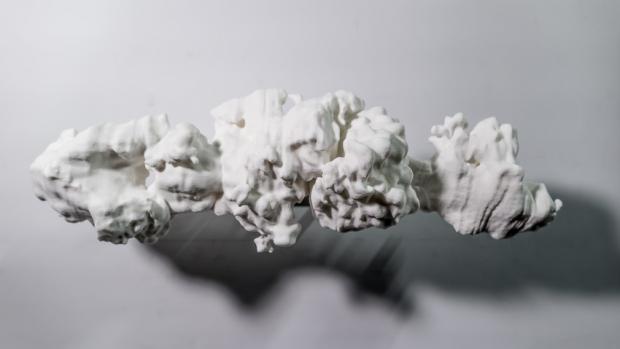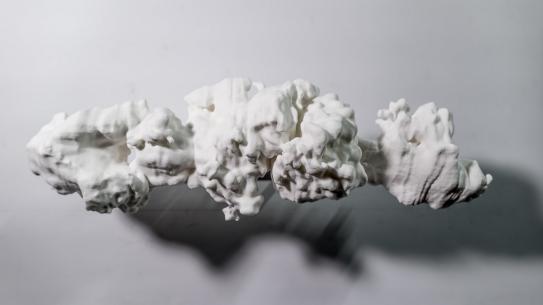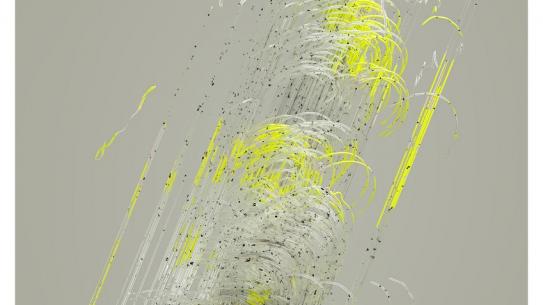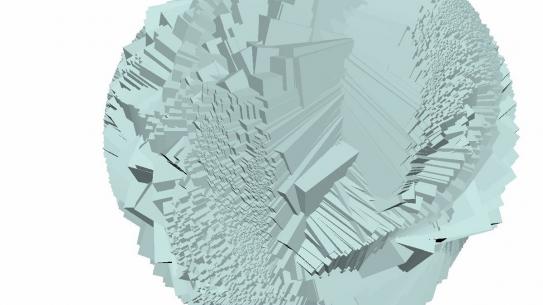Exhibit to Explore Great Scientific Mystery through Art
NYU Tandon School of Engineering Matches Scientists and Engineers with Artists, Collaborates with Helix Center for Interdisciplinary Investigation for Roundtable Discussion and Week-long Exhibit
“Creative Turbulence” Will Feature Works by Rafael Lozano-Hemmer and Others Probing Fluid Dynamics and Turbulence

“Atmospheric Memory” (from artist Rafael Lozano-Hemmer in collaboration with NYU Tandon School of Engineering researcher Enrico Fonda and Georgia Tech’s Devesh Ranjan) was inspired by Charles Babbage’s theory that spoken words have an everlasting impact on the universe.
BROOKLYN, New York – Scientists are still grasping to fully understand the dynamics of turbulence – which occurs when fluids move in a manner dictated by chaotic changes in pressure and flow velocity. In the 1970s, Nobel laureate Richard Feynman described it as “the most important unsolved problem of classical physics,” and it is now widely considered to be the field’s last unsolved problem.
From June 9 to 16, the Helix Center for Interdisciplinary Investigation will showcase “Creative Turbulence,” an exhibit that brings together art and science through a collaborative creative process based on the underlying nature of experimentation shared by those working in both disciplines. The organizers aim to challenge traditional notions of scientific perception and to engage viewers – even those with no scientific background – in a new way of considering complex physical phenomena and concepts like chaos theory, randomness, and the motion of fluids.
The exhibit, at the New York Psychoanalytic Institute, 247 E. 82nd Street in New York City, will be open to the public at no charge, and will be accompanied by a roundtable discussion by artists, scientists, and engineers on Thursday evening, June 14. Speakers will address creativity and scientific research in entertaining and accessible fashion.
A variety of artworks will be on display, including:
- “Atmospheric Memory” (from artist Rafael Lozano-Hemmer in collaboration with NYU Tandon School of Engineering researcher Enrico Fonda and Georgia Tech’s Devesh Ranjan) was inspired by Charles Babbage’s theory that spoken words have an everlasting impact on the universe. Lozano-Hemmer uses vegetable glycerin and glycol to capture the 3D form of air turbulence as it exists the mouth of a volunteer, then created a permanent 3D version of the breath. Lozano-Hemmer displayed another piece in the series at Art Basel in Miami in 2016.
- “Collective Motion” (from artist David McLeod in collaboration with NYU Tandon Professor of Mechanical Engineering Maurizio Porfiri) uses state-of-the-art animation software to visualize the behavior of interactive agents that organize themselves in a collective motion. The concept is related to flocking (as birds do) and schooling (as fish do) — and more broadly to non-equilibrium systems undergoing a phase transition. The structured behavior of these active particles bridges the gap between the motion of living things and the motion of inactive matter, such as in classical fluid dynamics.
- “Immutable Swell” (from artist and NYU Tandon Integrated Digital Media Lecturer Dana Karwas) is a sculptural representation of an ocean wave as it breaks onto land. She created the artwork by extracting over 500,000 data points from a custom buoy sensor placed in the waters of Cape Cod. This data was combined with her own personal experience of swimming in the ocean to emerge as a complex 3D digital inscription of an ocean wave. By using software and motion analysis to observe the wave from a digital distance, Karwas was able to distill invisible structures in the wave. “Immutable Swell” represents an opportunity for viewers to make a connection to the powerful turbulence and mysterious patterns found in the ocean.
- Nimbus Atlas II (from artist Berndnaut Smilde) consists of a series of high-definition videos depicting human-made clouds emerging and decomposing in a void. The footage was captured with a high-speed camera, resulting in a slow-motion visualization of how clouds evolve, change shape, and reflect light. (His “indoor clouds” were recognized by Time Magazine as among the "Top Ten Inventions of 2012.")
Also available for viewing is the work of physicist Daniel P. Lathrop, who pioneered visualization techniques that make it possible to observe the mysteries of quantum fluids — which exhibit quantum mechanical effects at the macroscopic level — with the naked eye. Lathrop collaborated with physicist and NYU Tandon Dean Katepalli R. Sreenivasan and Fonda and used superfluid helium, which flows without friction and exists only near absolute zero.
“The strong visual component of many of the investigations being done in fluid dynamics makes it easy to showcase the results to a lay audience in a compelling and immediate way,” said Fonda, who organized the exhibit and roundtable. “Fluids are a part of everyone’s daily life – from stirring coffee, taking a shower, and applying perfume to flying or driving in various conditions – so everyone has at least an intuitive feel for how fluids behave. I think people find it easier to relate to this work than to other topics in physics, which despite being fascinating are more abstract and seemingly less applicable to their lives.”
The connection between art and turbulence came to public attention in 2004, when NASA released images captured by the Hubble Space Telescope’s Advanced Camera for Surveys that looked remarkably like the luminescent swirls depicted in Vincent van Gogh’s famous painting “Starry Night.” A multinational team of physicists subsequently explored the relationship between the turbulence van Gogh depicted and the natural phenomenon of fluid turbulence and found a shockingly precise — and inexplicable — mathematical correlation that continues to confound scientists and art historians today.
The June 14 roundtable discussion — also free and open to the public — will feature Fonda and Karwas, NYU Tandon Dean Katepalli Sreenivasan, artist and NYU Tandon Co-Director of Integrated Digital Media R. Luke DuBois, and NYU Professor of Psychology and Neural Science Denis Pelli. They will explore in lay terms the intersection of art and science and touch upon the many theoretical and philosophical implications of turbulence, including entropy, quantum fluid dynamics, condensed matter, and the emergence of complex, self-organized structures from chaos. The event will be live streamed by the Helix Center, an organization that draws together leaders from distinct spheres of knowledge in the arts and sciences.
- Find more information and exhibit hours at www.helixcenter.org/roundtables/creative-turbulence
- Watch the roundtable discussion online at youtube.com or vimeo.com
The American Physical Society helped fund “Creative Turbulence.”
Note: Images and video at http://dam.engineering.nyu.edu/?c=2091&k=433319550b
About the New York University Tandon School of Engineering
The NYU Tandon School of Engineering dates to 1854, the founding date for both the New York University School of Civil Engineering and Architecture and the Brooklyn Collegiate and Polytechnic Institute (widely known as Brooklyn Poly). A January 2014 merger created a comprehensive school of education and research in engineering and applied sciences, rooted in a tradition of invention and entrepreneurship and dedicated to furthering technology in service to society. In addition to its main location in Brooklyn, NYU Tandon collaborates with other schools within NYU, one of the country’s foremost private research universities, and is closely connected to engineering programs at NYU Abu Dhabi and NYU Shanghai. It operates Future Labs focused on start-up businesses in downtown Manhattan and Brooklyn and an award-winning online graduate program. For more information, visit engineering.nyu.edu.
About the Helix Center
The primary mission of The Helix Center is to draw together leaders from distinct spheres of knowledge in the arts, humanities, sciences, and technology for interdisciplinary roundtables, the unique format of which potentiates new ideas, new questions, and facilitates emergent creative qualities of mind less possible in conventional collaborations. Such a drawing together of leaders of various disciplines irrespective of their academic affiliation allows the Helix Center to function as a kind of university without walls. In addition, through audience attendance and its Q&A engagement with the roundtable participants, and live streamed and archived events, we aim to expand public understanding and appreciation of the sciences and technology, the arts and humanities. Its accompanying website engages a global community in high-level discourse through live webcasts and continuing discussions arising from each roundtable. The Helix Center also provides educational outreach through poetry discussions and music programs made available to teachers and schools. The center is a 501(c)(3)–i.e., tax-exempt, non-profit–organization. For more information, visit helixcenter.org.









